Brief Overview of Air Sand Blasters
Air sand blasters are powerful tools used in a variety of industries, from automotive repair to construction. They are designed to clean, smooth, or shape surfaces using a high-pressure stream of abrasive material. The process of sandblasting, or abrasive blasting, is essential for removing rust, old paint, and other surface imperfections that can affect the performance and appearance of machinery, buildings, and other structures.
Despite their name, air sand blasters can use a variety of abrasive materials, not just sand. These can include glass beads, steel grit, and even walnut shells, depending on the specific task at hand. The versatility of these tools makes them invaluable in many professional settings.
While air sand blasters are commonly used in industrial settings, they are also popular among hobbyists and DIY enthusiasts. Smaller, portable models can be used for a variety of home projects, from restoring old furniture to creating custom etched glass designs.
Our Top Air Sand Blaster Picks
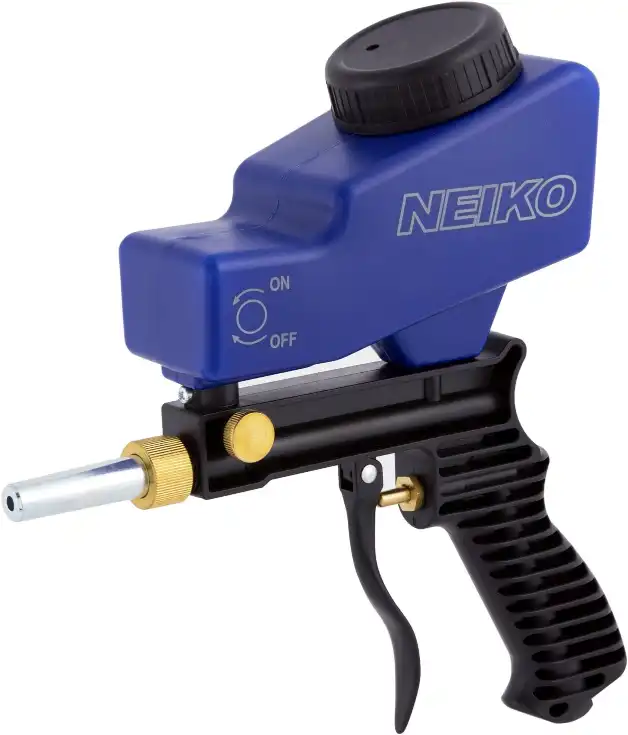
NEIKO 30068A Air Sand Blaster Gun
Check on AmazonKey Specifications:
- Operating Pressure: 90 PSI
- Air Consumption: 7 SCFM
- Nozzle Size: 5.0 mm, 2-15/16” x 7/32” diameter
- Media Compatibility: Silicon carbide, sand, aluminum oxide, and more
- Special Feature: Gravity feed system for efficient abrasive delivery
The NEIKO 30068A Air Sand Blaster Gun is an exceptional tool for heavy-duty cleaning and surface preparation. Its gravity feed system ensures a continuous flow of abrasive media, making it ideal for tasks like paint stripping, rust removal, and cleaning grout or tiles. The ergonomic design makes it easy to handle, and its versatility shines with compatibility for various media types like sand and aluminum oxide. Powered by compressed air, it delivers powerful performance for both industrial and DIY applications.
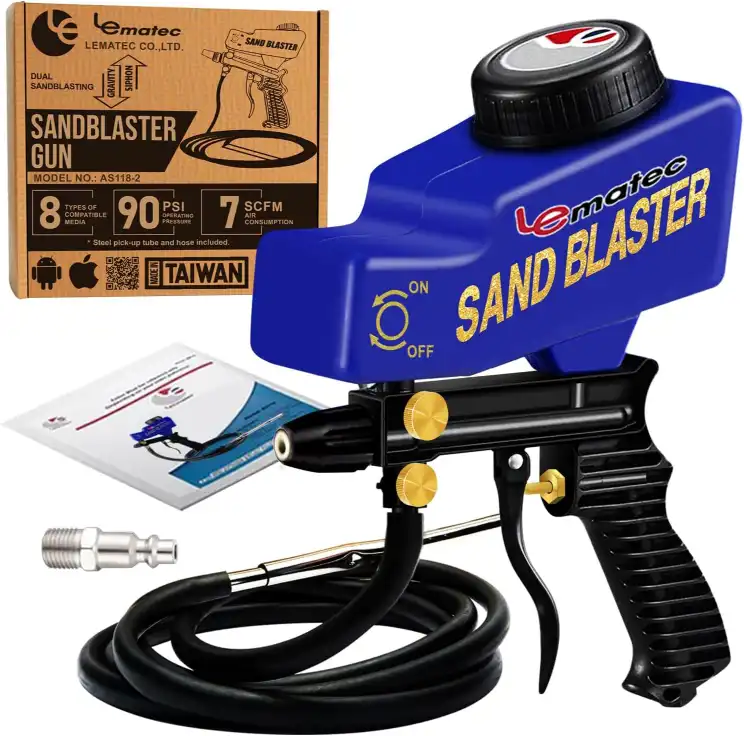
LE LEMATEC Portable Sandblaster Gun Kit
Check on AmazonKey Specifications:
- Operating Pressure: Up to 120 PSI
- Nozzle Material: Durable ceramic
- Media Compatibility: Sand, soda, walnut shells
- Included Components: 7’ siphon hose, steel pickup tube
- Weight: 0.99 kg (2.18 lbs)
The LE LEMATEC AS118-2C Portable Sandblaster Kit is a versatile and powerful tool for professional-quality surface preparation. It efficiently removes rust and paint, thanks to its high blast pressure of up to 120 PSI. The included ceramic nozzle ensures a smooth, uninterrupted media flow for a consistent result. I particularly appreciate its lightweight design, making it easy to handle for long hours, and its compatibility with multiple media types like soda, sand, and walnut shells. It’s perfect for auto, metal, wood, and DIY projects.
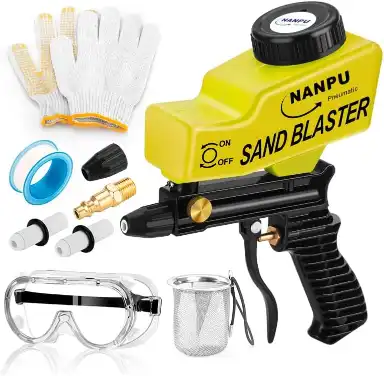
NANPU Air Sand Blaster Gun
Check on AmazonKey Specifications:
- Operating Pressure: 90 PSI
- Air Consumption: 7 SCFM
- Nozzle Material: Durable ceramic
- Included Accessories: 3 ceramic nozzles, 2 nozzle guards, gloves, goggles
- Weight: 2.44 lbs
The NANPU Air Sand Blaster Gun with a gravity feed system is a fantastic tool for both heavy-duty and detailed cleaning tasks. Its adjustable ceramic nozzle allows precise control over the sandblasting pattern, making it ideal for tasks like rust removal, paint stripping, and glass etching. I appreciate the ergonomic grip, which ensures comfort during extended use. Additionally, it’s compatible with various media like sand, soda, and walnut shells, providing versatility for different surfaces and projects. The durable construction and accessories make it a complete solution for surface preparation.
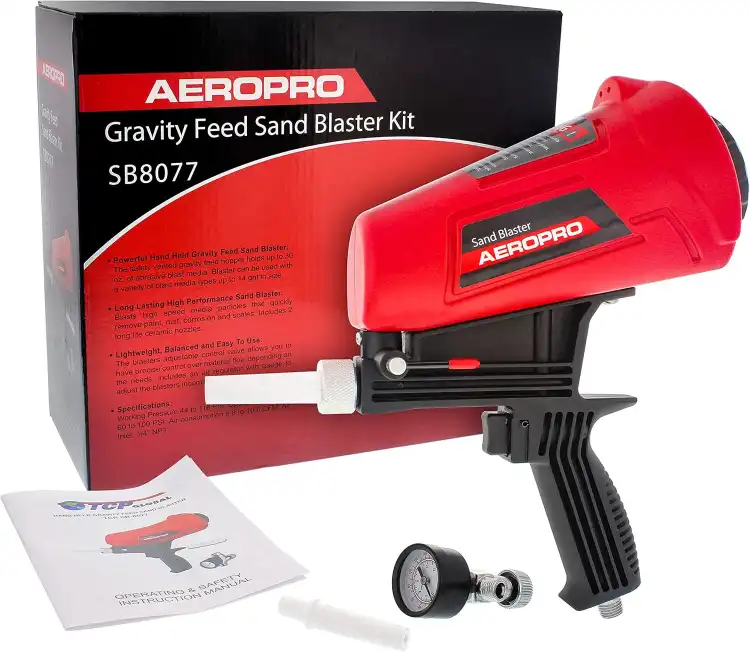
TCP Global Gravity Feed Sand Blaster Gun Kit
Check on AmazonKey Specifications:
- Operating Pressure: 60-100 PSI
- Air Consumption: 8.8-10.6 CFM
- Nozzle Size: 5mm
- Capacity: 30oz
- Air Inlet: 1/4″ NPT
The TCP Global Gravity Feed Sand Blaster Gun Kit is a powerful, yet ergonomic tool for all your abrasive blasting needs. With a 30oz capacity and 2 included ceramic nozzles, it’s perfect for removing rust, paint, and corrosion from metal, wood, and other surfaces. The adjustable material flow and pressure gauge ensure precise control, while its lightweight design makes it easy to handle. Whether you’re working on DIY projects or automotive restorations, this sandblaster delivers efficient, high-speed performance.
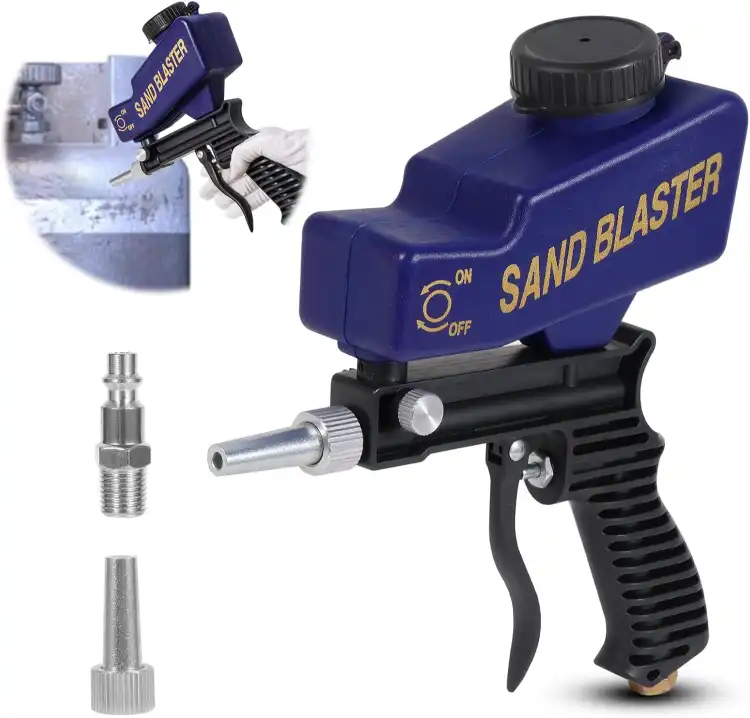
Ziopetru Sand Blaster Gun
Check on AmazonKey Specifications:
- Operating Pressure: 70-150 PSI
- Included Nozzles: 1 durable steel nozzle
- Adjustable Flow Valve: Yes, for particle size control
- Weight: 1.06 pounds
- Applications: Metal, wood, rust, paint, glass etching
The Ziopetru Gravity Feed Sandblaster Gun is an excellent choice for precision sandblasting. Its adjustable flow valve allows you to control the particle size, minimizing waste while providing efficient results. The durable steel nozzles ensure long-lasting performance, reducing the need for frequent replacements. Whether you’re removing rust, polishing metal, or tackling DIY projects like glass etching, this lightweight, ergonomic sandblaster delivers reliable power. Its versatility makes it ideal for both professional use and home improvement tasks.
Importance of Choosing the Right Air Sand Blaster
Choosing the right air sand blaster is crucial for achieving the desired results in your projects. The type, size, and power of the blaster can significantly affect its performance and the quality of the finished product. Therefore, it’s important to understand the different options available and how they align with your specific needs and goals.
Furthermore, using the wrong type of air sand blaster can lead to unnecessary wear and tear on the tool, reducing its lifespan. It can also pose safety risks, especially if the blaster is too powerful for the task or if it’s used without the proper safety equipment.
Finally, choosing the right air sand blaster can also have financial implications. High-quality, professional-grade models can be quite expensive, so it’s important to ensure that the tool you choose is a good investment that will meet your needs without breaking the bank.
Understanding Air Sand Blasters
Definition and Function of Air Sand Blasters
Air sand blasters, also known as abrasive blasters, are tools that use compressed air to propel abrasive material at high speeds onto a surface. The abrasive material, or media, can be anything from sand to glass beads, depending on the specific application. The high-speed impact of the media removes surface materials such as rust, paint, or other contaminants, leaving the underlying surface clean and smooth.
The primary function of an air sand blaster is to clean and prepare surfaces for painting, coating, or other treatments. They are commonly used in industries such as automotive repair, construction, and manufacturing, where they can quickly and efficiently remove old paint, rust, and other surface imperfections.
However, air sand blasters can also be used for more delicate tasks, such as etching designs onto glass or stone. In these cases, the blaster is typically used at a lower pressure and with a finer abrasive media to avoid damaging the surface.
Different Types of Air Sand Blasters
There are several different types of air sand blasters, each designed for specific applications. The most common types include pressure blasters, suction blasters, and gravity-fed blasters.
Pressure blasters use a pressurized tank to store the abrasive media, which is then propelled out of the nozzle when the trigger is pulled. This type of blaster is typically more powerful and efficient than other types, making it ideal for heavy-duty tasks such as removing rust from large machinery or stripping paint from buildings.
Suction blasters, also known as siphon blasters, use a suction mechanism to draw the abrasive media into the air stream. This type of blaster is typically less powerful than a pressure blaster, but it’s also less expensive and easier to use, making it a popular choice for home use and smaller projects.
Gravity-fed blasters, as the name suggests, use gravity to feed the abrasive media into the air stream. These blasters are typically small and portable, making them ideal for small projects and spot cleaning.
How Air Sand Blasters Work
Air sand blasters work by using compressed air to propel abrasive media at high speeds onto a surface. The process begins when the operator pulls the trigger on the blaster’s gun, which opens a valve and allows the compressed air to flow into the blaster.
The air then passes through a mixing chamber, where it picks up the abrasive media. The mixture of air and media is then propelled out of the nozzle and onto the surface being blasted.
The high-speed impact of the media removes surface materials such as rust, paint, or other contaminants. The used media and removed material are then collected in a recovery system for disposal or recycling.
Factors to Consider When Buying an Air Sand Blaster
Purpose and Usage
The first factor to consider when buying an air sand blaster is its intended purpose and usage. Different types of blasters are designed for different tasks, so it’s important to choose a model that aligns with your specific needs.
For example, if you need a blaster for heavy-duty tasks such as removing rust from large machinery or stripping paint from buildings, a powerful pressure blaster would be a good choice. On the other hand, if you need a blaster for smaller projects or delicate tasks such as etching designs onto glass, a less powerful suction or gravity-fed blaster would be more suitable.
It’s also important to consider how often you plan to use the blaster. If you only need it for occasional use, a less expensive model may be sufficient. However, if you plan to use the blaster regularly or for long periods of time, it’s worth investing in a higher-quality model that can withstand heavy use.
Size and Portability
The size and portability of the air sand blaster are also important factors to consider. If you need a blaster for large projects or if you need to move it around frequently, a larger, more powerful model may be necessary. However, these models can be heavy and difficult to maneuver, so it’s important to ensure that you have the necessary space and equipment to handle them.
If you need a blaster for smaller projects or if space is a concern, a smaller, more portable model may be a better choice. These models are typically less powerful than their larger counterparts, but they are easier to handle and can be used in a variety of settings.
Some air sand blasters also come with wheels or handles for easy transport. These features can be especially useful if you need to move the blaster around a large work area or transport it to different locations.
Power and Performance
The power and performance of the air sand blaster are crucial factors to consider. The power of the blaster, typically measured in pounds per square inch (PSI), determines how fast and efficiently it can remove surface materials. A higher PSI means a more powerful blaster, but it also means a higher price tag and potentially more wear and tear on the tool.
The performance of the blaster, on the other hand, refers to how well it can perform its intended tasks. This can be influenced by a variety of factors, including the type and size of the abrasive media, the design of the nozzle, and the quality of the components.
When evaluating the power and performance of an air sand blaster, it’s important to consider your specific needs and goals. A powerful, high-performance blaster may be necessary for heavy-duty tasks, but it may be overkill for smaller projects or delicate tasks.
Material Compatibility
Another important factor to consider when buying an air sand blaster is the compatibility of the blaster with different types of abrasive media. Different types of media are suited to different tasks, so it’s important to choose a blaster that can accommodate the media you plan to use.
For example, if you need to remove rust from metal, a blaster that can use steel grit would be a good choice. On the other hand, if you need to etch designs onto glass, a blaster that can use fine glass beads would be more suitable.
It’s also important to consider the cost and availability of the abrasive media. Some types of media, such as sand, are inexpensive and widely available, while others, such as walnut shells or glass beads, can be more expensive and harder to find.
Price and Budget Considerations
Finally, price and budget considerations are crucial when buying an air sand blaster. High-quality, professional-grade models can be quite expensive, so it’s important to ensure that the tool you choose is a good investment that will meet your needs without breaking the bank.
When setting your budget, it’s important to consider not only the initial cost of the blaster, but also the ongoing costs of operation and maintenance. These can include the cost of the abrasive media, replacement parts, and energy costs for running the blaster.
It’s also worth considering the potential savings that a good air sand blaster can provide. By allowing you to clean and prepare surfaces quickly and efficiently, a good blaster can save you time and labor costs, making it a valuable investment in the long run.
Detailed Review of Top Air Sand Blasters
Review of Top Portable Air Sand Blasters
When it comes to portable air sand blasters, there are several top-rated models to consider. These include the Black Bull SFSB90, the Campbell Hausfeld AT122601AV, and the Lematec Portable AS118.
The Black Bull SFSB90 is a gravity-fed blaster that is compact and lightweight, making it ideal for small projects and spot cleaning. It has a 7.5-gallon tank and can operate at pressures up to 125 PSI, making it powerful enough for most home use.
The Campbell Hausfeld AT122601AV is a suction blaster that is designed for easy use and portability. It has a 30-pound capacity and can operate at pressures up to 125 PSI. It also comes with a 10-foot hose and a durable, easy-to-use gun.
The Lematec Portable AS118 is a versatile blaster that can be used with a variety of abrasive media. It has a compact, handheld design that makes it easy to maneuver, and it can operate at pressures up to 90 PSI. It also features an adjustable control valve for precise control over the media flow.
Review of Top Professional-Grade Air Sand Blasters
For professional-grade air sand blasters, some of the top models include the Grizzly Industrial G0707, the ALC Keysco 40002, and the Cyclone Manufacturing FT6035.
The Grizzly Industrial G0707 is a pressure blaster that is designed for heavy-duty tasks. It has a 110-pound capacity and can operate at pressures up to 125 PSI. It also features a large viewing window and a built-in dust collector for easy operation and cleanup.
The ALC Keysco 40002 is a pressure blaster that is designed for professional use. It has a 90-pound capacity and can operate at pressures up to 125 PSI. It also features a durable, steel construction and a large, easy-to-fill tank.
The Cyclone Manufacturing FT6035 is a pressure blaster that is designed for industrial use. It has a 35-pound capacity and can operate at pressures up to 125 PSI. It also features a large, top-loading design and a built-in dust collector for easy operation and cleanup.
Review of Top Budget-Friendly Air Sand Blasters
If you’re on a budget, there are several affordable air sand blasters that still offer good performance. These include the Performance Tool M549, the Neiko 30042A, and the Generic Air Sand Blaster.
The Performance Tool M549 is a gravity-fed blaster that is compact and lightweight, making it ideal for small projects and spot cleaning. It has a 15-pound capacity and can operate at pressures up to 90 PSI. It also comes with a 5-foot hose and a durable, easy-to-use gun.
The Neiko 30042A is a gravity-fed blaster that is designed for easy use and portability. It has a 20-pound capacity and can operate at pressures up to 90 PSI. It also comes with a 10-foot hose and a durable, easy-to-use gun.
The Generic Air Sand Blaster is a versatile blaster that can be used with a variety of abrasive media. It has a compact, handheld design that makes it easy to maneuver, and it can operate at pressures up to 90 PSI. It also features an adjustable control valve for precise control over the media flow.
Safety Measures When Using Air Sand Blasters
Importance of Safety When Using Air Sand Blasters
Safety is of utmost importance when using air sand blasters. These tools operate at high pressures and can propel abrasive media at high speeds, posing a risk of injury if not used properly. Furthermore, the process of sandblasting can generate dust and debris, which can be harmful if inhaled or if it comes into contact with the skin or eyes.
Therefore, it’s crucial to follow all safety guidelines when using an air sand blaster. This includes wearing the proper safety equipment, using the tool in a well-ventilated area, and following all manufacturer’s instructions for operation and maintenance.
By taking these precautions, you can ensure that you can use your air sand blaster safely and effectively, without risking injury or damage to your health.
Safety Equipment Needed
When using an air sand blaster, it’s important to wear the proper safety equipment. This includes safety goggles to protect your eyes from flying debris, a dust mask or respirator to protect your lungs from dust and other airborne particles, and gloves to protect your hands from the abrasive media.
In addition to these basic items, it’s also a good idea to wear a long-sleeved shirt and long pants to protect your skin from the abrasive media. If you’re working in a particularly dusty environment, you may also want to consider wearing a full-face mask or a blast hood for additional protection.
Finally, it’s important to use ear protection when using an air sand blaster. These tools can be quite loud, especially when used in a confined space, and prolonged exposure to high noise levels can lead to hearing damage.
Proper Usage and Handling
Proper usage and handling are crucial for ensuring safety when using an air sand blaster. This includes following all manufacturer’s instructions for operation and maintenance, as well as taking precautions to prevent accidental discharge or other mishaps.
When using an air sand blaster, it’s important to maintain a safe distance from the surface being blasted. This not only protects you from flying debris, but also allows for better control over the blaster and a more even application of the abrasive media.
It’s also important to use the blaster in a well-ventilated area to prevent the buildup of dust and other airborne particles. If you’re working indoors, make sure to use a dust collector or other ventilation system to keep the air clean.
Finally, it’s important to handle the blaster with care to prevent accidental discharge or other mishaps. This includes keeping the trigger locked when not in use, disconnecting the air supply when changing the abrasive media, and regularly inspecting the blaster for any signs of damage or wear.
Maintenance and Care for Air Sand Blasters
Routine Maintenance Practices
Regular maintenance is crucial for ensuring the longevity and performance of your air sand blaster. This includes cleaning the blaster after each use, regularly inspecting it for any signs of damage or wear, and replacing any worn or damaged parts as needed.
After each use, it’s important to thoroughly clean the blaster to remove any residual abrasive media or debris. This can be done by running a cleaning solution through the blaster, or by disassembling it and cleaning each part individually. Be sure to follow the manufacturer’s instructions for cleaning to avoid damaging the blaster.
Regular inspections are also crucial for catching any potential issues before they become serious problems. This includes checking the blaster for any signs of damage or wear, such as cracks in the tank, leaks in the hoses, or wear on the nozzle. If you notice any issues, be sure to address them as soon as possible to prevent further damage.
Finally, it’s important to replace any worn or damaged parts as needed. This includes the nozzle, which can wear out over time due to the abrasive nature of the media, as well as any seals or gaskets that may wear out or become damaged. Be sure to use only manufacturer-approved parts to ensure the best performance and longevity of your blaster.
Troubleshooting Common Issues
Despite your best maintenance efforts, you may occasionally encounter issues with your air sand blaster. Common issues include low pressure, inconsistent media flow, and leaks.
If you’re experiencing low pressure, the issue may be with the air supply. Check to make sure the air compressor is working properly and that the air hose is not kinked or blocked. If the pressure is still low, the issue may be with the blaster itself, such as a worn nozzle or a clogged media valve.
If the media flow is inconsistent, the issue may be with the media itself. Make sure the media is dry and free of clumps, and that it’s the correct size for your blaster. If the media flow is still inconsistent, the issue may be with the blaster, such as a worn or clogged media valve.
If you notice any leaks, it’s important to address them as soon as possible to prevent further damage. Check all hoses, connections, and seals for any signs of damage or wear, and replace any worn or damaged parts as needed.
Long-Term Care and Storage
Proper long-term care and storage are crucial for ensuring the longevity of your air sand blaster. This includes cleaning the blaster thoroughly before storing it, storing it in a dry, protected location, and periodically inspecting it for any signs of damage or wear.
Before storing your blaster, it’s important to clean it thoroughly to remove any residual abrasive media or debris. This can be done by running a cleaning solution through the blaster, or by disassembling it and cleaning each part individually. Be sure to dry the blaster thoroughly before storing it to prevent rust or other damage.
When storing your blaster, choose a dry, protected location that is free of dust and other contaminants. If possible, store the blaster in its original packaging to provide additional protection. Avoid storing the blaster in areas with high humidity or extreme temperatures, as these can cause damage over time.
Finally, even when stored, it’s important to periodically inspect your blaster for any signs of damage or wear. This includes checking for any signs of rust, checking all seals and gaskets for any signs of wear, and checking the nozzle for any signs of wear or damage. If you notice any issues, be sure to address them as soon as possible to prevent further damage.
Conclusion
Recap of Air Sand Blaster Buying Guide
Choosing the right air sand blaster is crucial for achieving the desired results in your projects. By understanding the different types of blasters, how they work, and the factors to consider when buying one, you can make an informed decision that aligns with your specific needs and goals.
Whether you need a blaster for heavy-duty tasks such as removing rust from large machinery, or for delicate tasks such as etching designs onto glass, there’s a model out there that’s right for you. By choosing the right blaster, you can ensure that your projects are completed quickly, efficiently, and safely.
Remember to always follow all safety guidelines when using an air sand blaster, and to maintain your blaster properly to ensure its longevity and performance. With the right care and handling, your air sand blaster can be a valuable tool that serves you well for many years to come.
Final Thoughts and Recommendations
When it comes to air sand blasters, there’s no one-size-fits-all solution. The best blaster for you depends on your specific needs, goals, and budget. However,
